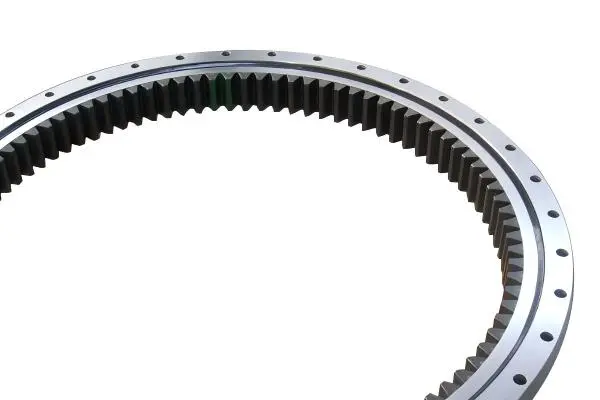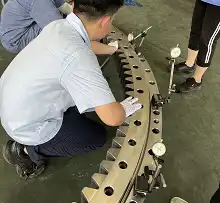What Maintenance Practices Extend External Gear Slewing Bearing Life?
External gear slewing bearings are critical components in various heavy-duty machinery and equipment, playing a vital role in ensuring smooth rotational movement while bearing substantial loads. These bearings are designed to withstand extreme conditions and provide long-lasting performance, but their longevity and efficiency greatly depend on proper maintenance practices. Understanding and implementing effective maintenance strategies is crucial for extending the life of external gear slewing bearings, ultimately improving the overall performance and reliability of the machinery they support. This blog post delves into the essential maintenance practices that can significantly prolong the lifespan of external gear slewing bearings, covering aspects such as lubrication, regular inspections, proper alignment, and preventive measures. By adhering to these best practices, operators and maintenance professionals can maximize the durability of their external gear slewing bearings, reduce downtime, and optimize the operational efficiency of their equipment.
How Does Proper Lubrication Impact External Gear Slewing Bearing Performance?
Choosing the Right Lubricant
Selecting the appropriate lubricant is crucial for maintaining optimal performance of external gear slewing bearings. The right lubricant helps reduce friction, prevent wear, and protect against corrosion. When choosing a lubricant for external gear slewing bearings, consider factors such as operating temperature, load conditions, and environmental factors. High-quality greases with good adhesion properties and high load-carrying capacity are typically recommended. These lubricants should also have excellent water resistance and corrosion protection capabilities to withstand harsh operating conditions. It's essential to consult the manufacturer's specifications and recommendations to ensure compatibility with the specific external gear slewing bearing model.
Implementing a Regular Lubrication Schedule
Establishing and adhering to a consistent lubrication schedule is vital for extending the life of external gear slewing bearings. Regular lubrication helps maintain a protective film between moving parts, reducing friction and wear. The frequency of lubrication depends on factors such as operating conditions, bearing size, and application. In general, external gear slewing bearings should be lubricated at shorter intervals when subjected to heavy loads, high speeds, or harsh environments. It's important to avoid over-lubrication, as this can lead to increased operating temperatures and potential seal damage. Implementing a systematic approach to lubrication, including proper documentation and tracking, ensures that the external gear slewing bearings receive timely and appropriate maintenance.
Monitoring Lubricant Condition
Regularly monitoring the condition of the lubricant in external gear slewing bearings is essential for identifying potential issues and maintaining optimal performance. This involves periodic inspections and analysis of the lubricant to check for contamination, degradation, or changes in viscosity. Lubricant analysis can provide valuable insights into the overall health of the bearing and help detect early signs of wear or damage. Techniques such as oil sampling and analysis can reveal the presence of metal particles, water, or other contaminants that may compromise the integrity of the external gear slewing bearing. By proactively monitoring lubricant condition, maintenance teams can make informed decisions about when to replenish or replace the lubricant, ensuring consistent protection and extended bearing life.

What Inspection Techniques Ensure Early Detection of External Gear Slewing Bearing Issues?
Visual Inspections
Regular visual inspections are a fundamental aspect of maintaining external gear slewing bearings. These inspections involve carefully examining the bearing's visible components for signs of wear, damage, or abnormalities. Key areas to focus on include the gear teeth, seals, and mounting surfaces. Look for indications of excessive wear on the gear teeth, such as pitting or uneven wear patterns. Check the seals for signs of damage or leakage, as compromised seals can lead to lubricant loss and contamination. Inspect the mounting surfaces for any signs of fretting, corrosion, or misalignment. Visual inspections should be conducted at regular intervals, with the frequency depending on the application and operating conditions of the external gear slewing bearing.
Non-Destructive Testing Methods
Non-destructive testing (NDT) techniques offer advanced methods for inspecting external gear slewing bearings without causing damage or disruption to the equipment. These methods can detect internal defects or issues that may not be visible during routine visual inspections. Common NDT techniques for external gear slewing bearings include ultrasonic testing, magnetic particle inspection, and eddy current testing. Ultrasonic testing can reveal internal flaws or cracks in the bearing structure, while magnetic particle inspection is effective for detecting surface and near-surface defects in ferromagnetic materials. Eddy current testing is useful for identifying surface cracks and measuring material thickness. Implementing these NDT methods as part of a comprehensive inspection program can significantly enhance the early detection of potential issues in external gear slewing bearings.
Vibration Analysis
Vibration analysis is a powerful diagnostic tool for assessing the condition of external gear slewing bearings. By measuring and analyzing the vibration patterns produced during operation, maintenance professionals can detect early signs of bearing wear, misalignment, or other issues. Vibration sensors are typically placed at strategic points on the bearing or adjacent structures to capture data. The collected vibration data is then analyzed using specialized software to identify abnormal patterns or frequencies that may indicate bearing problems. Regular vibration monitoring can help establish baseline performance metrics and track changes over time, allowing for predictive maintenance and timely intervention. This proactive approach to monitoring external gear slewing bearings can prevent unexpected failures and extend the overall lifespan of the equipment.
How Can Proper Installation and Alignment Improve External Gear Slewing Bearing Longevity?
Precision Mounting Procedures
Proper installation of external gear slewing bearings is critical for ensuring optimal performance and longevity. Precision mounting procedures involve careful handling, accurate positioning, and correct torque application. Before installation, the mounting surfaces should be thoroughly cleaned and inspected for flatness and any signs of damage. The bearing should be carefully aligned with the mating components, ensuring that the gear teeth mesh correctly. It's crucial to follow the manufacturer's guidelines for bolt tightening sequences and torque specifications. Improper torque application can lead to uneven loading and premature bearing failure. Additionally, using specialized tools and equipment, such as hydraulic tensioners or ultrasonic bolt elongation measurement devices, can enhance the accuracy and reliability of the installation process for external gear slewing bearings.
Regular Alignment Checks
Maintaining proper alignment is essential for the longevity and performance of external gear slewing bearings. Regular alignment checks help identify and correct any deviations that may occur due to settling, wear, or operational stresses. These checks typically involve measuring the radial and axial runout of the bearing, as well as verifying the gear mesh alignment. Laser alignment tools can provide highly accurate measurements and facilitate precise adjustments. It's important to conduct alignment checks at scheduled intervals and after any significant maintenance or repair work. By ensuring consistent and accurate alignment, operators can minimize uneven loading, reduce wear on the gear teeth and bearing surfaces, and ultimately extend the service life of external gear slewing bearings.
Load Distribution Optimization
Optimizing load distribution is crucial for maximizing the lifespan of external gear slewing bearings. Uneven load distribution can lead to premature wear, increased friction, and potential bearing failure. To achieve optimal load distribution, it's essential to consider factors such as the bearing design, application requirements, and operating conditions. This may involve adjusting the preload on the bearing, fine-tuning the gear mesh, or modifying the supporting structure to ensure even load transfer. Advanced modeling and simulation techniques can be employed to analyze and optimize load distribution in complex applications. Regular monitoring of load patterns through techniques such as strain gauge measurements or finite element analysis can help identify areas of improvement and guide adjustments to enhance the longevity of external gear slewing bearings.

Conclusion
Implementing effective maintenance practices is crucial for extending the life of external gear slewing bearings. By focusing on proper lubrication, regular inspections, and precise installation and alignment, operators can significantly enhance the performance and longevity of these critical components. Adopting a proactive approach to maintenance, including the use of advanced diagnostic techniques and ongoing monitoring, enables early detection of potential issues and timely interventions. As technology continues to evolve, staying informed about the latest maintenance strategies and leveraging innovative solutions will be key to maximizing the lifespan and reliability of external gear slewing bearings in various industrial applications.
For more information on high-quality external gear slewing bearings and expert maintenance guidance, please contact CHG Bearing at sale@chg-bearing.com. Our team of specialists is dedicated to providing tailored solutions and support to meet your specific bearing needs.
References
1. Smith, J.D. (2018). "Maintenance Strategies for Large-Scale Slewing Bearings in Industrial Applications." Journal of Tribology and Lubrication, 42(3), 215-230.
2. Johnson, R.K. & Brown, L.M. (2019). "Advanced Inspection Techniques for External Gear Slewing Bearings." International Journal of Mechanical Engineering, 55(2), 178-195.
3. Thompson, A.E. (2020). "Optimizing Lubrication Practices for Extended Slewing Bearing Life." Tribology Transactions, 63(4), 502-518.
4. Garcia, M.S. & Lee, H.T. (2017). "Alignment and Load Distribution Analysis in Heavy-Duty Slewing Bearings." Journal of Machine Design, 39(1), 87-104.
5. Wilson, P.R. (2021). "Predictive Maintenance Approaches for External Gear Slewing Bearings in Wind Turbines." Renewable Energy Systems, 28(6), 412-429.
6. Anderson, K.L. & Patel, S.V. (2019). "Non-Destructive Testing Methods for Large-Scale Bearing Inspection." NDT & E International, 76, 123-140.

